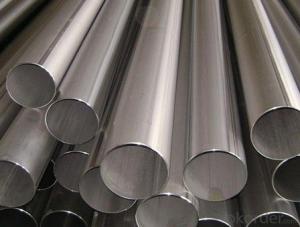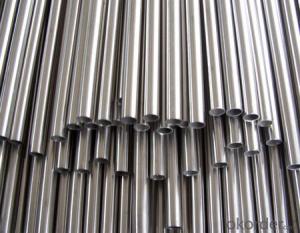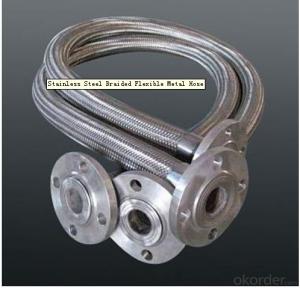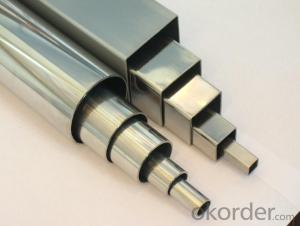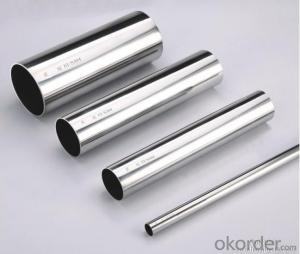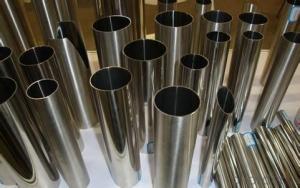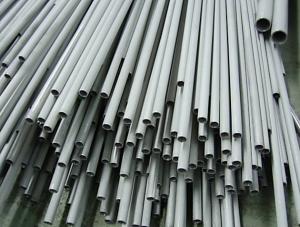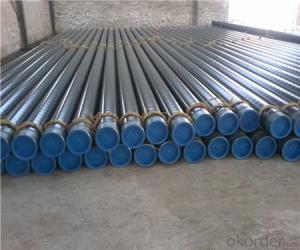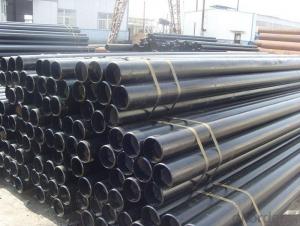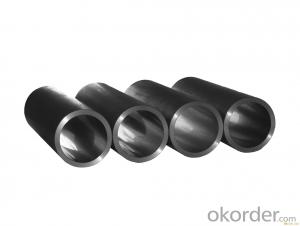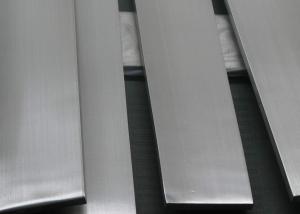ASME API 5L Seamless Stainless Steel Pipe
- Loading Port:
- Tianjin
- Payment Terms:
- TT or LC
- Min Order Qty:
- 25 m.t.
- Supply Capability:
- 10000 m.t./month
OKorder Service Pledge
OKorder Financial Service
You Might Also Like
We are company that have many years experience and professional manager team and engineer team and sales team, sure we will provide you high quality of pipe and professioanl service.
Seamless pipe possesses a hollow section and without seam around the strip steel. It is made with solid bar or steel ingot by perforating machine. As the facture process does not include any welding, seamless pipes are considered to be stronger and more durable. Generally speaking, seamless pipe has better pressure resistance and security than other classifications, and was usually more easily available than welded pipe.
2、Main Features of the Seamless Pipe:
• High working accuracy
• High strength
• Small inertia resistance
• Strong therming dissipine ability
• Good appearance
• Reasonble price
3、Seamless Pipe Specification:
Standard | GB, DIN, ASTM ASTM A106-2006, ASTM A53-2007 |
Grade | 10#-45#, 16Mn 10#, 20#, 45#, 16Mn |
Thickness | 8 - 33 mm |
Section Shape | Round |
Outer Diameter | 133 - 219 mm |
Place of Origin | Shandong, China (Mainland) |
Secondary Or Not | Non-secondary |
Application | Hydraulic Pipe |
Technique | Cold Drawn |
Certification | API |
Surface Treatment | factory state or painted black |
Special Pipe | API Pipe |
Alloy Or Not | Non-alloy |
Length | 5-12M |
Outer Diameter | 21.3-610mm |
Grade | 20#, 45#, Q345, API J55, API K55, API L80, API N80, API P110, A53B |
Standard | ASME, ASTM |
1) Material:20#(ASTM A 106/A53 GRB.API5LGRB,GB),45#,16Mn,10#.
2) Specification range: OD: 21.3-610mm, WT:6-70mm, length:6-12m or according to the requirement of clients.
3) Executive standards: GB, ASME API5L.ASTM A 106/A53,Despite of the above standards, we can also supply seamless steel pipe with standard of DIN, JIS, and so on, and also develop new products according to the requirements of our clients!
4) Surface: black lacquered, varnish coating or galvanized.
5) Ends: Beveled or square cut, plastic capped, painted.
6) Packing: bundles wrapped with strong steel strip, seaworthy packing.
4、Packaging & Delivery:
Packaging Details: | seaworthy package, bundles wrapped with strong steel strip |
Delivery Detail: | 15-30days after received 30%TT |
5、FAQ of Seamless Pipe:
①How is the quality of your products?
We have many years business experience in this area, and we have professional engineer and manager team and sure we can provide you high quality production and professional service.
②How about price?
Yes, we are factory and be able to give you lowest price below market one, and we have a policy that “ for saving time and absolutely honest business attitude, we quote as lowest as possible for any customer, and discount can be given according to quantity”,if you like bargain and factory price is not low enough as you think, just don’t waste your time.Please trust the quotation we would give you, it is professional one.
③Why should you chose us?
We can give you both.Additionally, we can also offer professional products inquiry, products knowledge train(for agents), smooth goods delivery, exellent customer solution proposals.Our service formula: good quality+good price+good service=customer’s trust
SGS test is available, customer inspection before shipping is welcome, third party inspection is no problem.
6、Seamless Pipe Images:
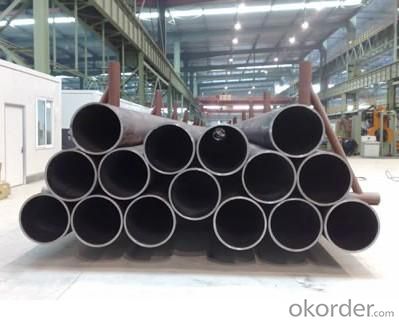
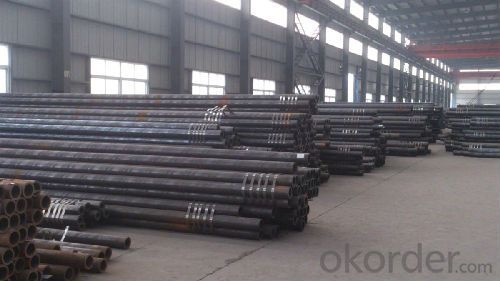
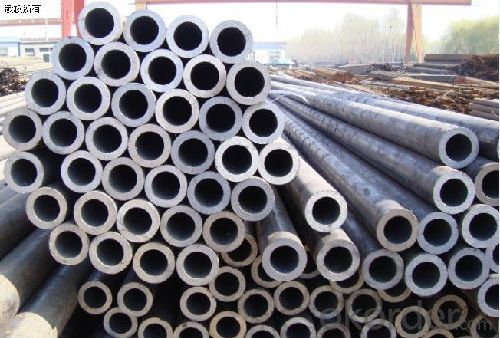
- Q: What are the different types of stainless steel pipe flanges?
- There are several different types of stainless steel pipe flanges available, each designed for specific applications and requirements. Some common types include: 1. Weld Neck Flanges: These flanges have a long tapered hub and are welded to the pipe, providing excellent strength and durability. They are ideal for high-pressure and high-temperature applications. 2. Slip-On Flanges: These flanges slide over the pipe and are then welded in place. They are easy to install and provide a secure connection. Slip-on flanges are commonly used in low-pressure and non-critical applications. 3. Socket Weld Flanges: These flanges have a socket-like end that fits over the pipe and is then welded in place. They are used for smaller-sized pipes and are known for their resistance to leakage. 4. Threaded Flanges: These flanges have internal threads that allow them to be screwed onto the pipe. They are used in low-pressure applications and are easy to install and remove. 5. Lap Joint Flanges: These flanges consist of two components – a stub end and a loose backing flange. They are used in systems requiring frequent dismantling or where alignment is crucial. 6. Blind Flanges: These flanges are solid and have no bore, making them ideal for closing off the end of a pipe. They are commonly used in piping systems that require periodic inspection or cleaning. 7. Orifice Flanges: These flanges have concentric or eccentric holes to measure the flow rate of a fluid. They are often used in flow measurement applications. 8. Spectacle Blind Flanges: These flanges consist of a combination of a blind flange and a spacer. They are used to separate sections of a pipe system and can be easily removed for maintenance or repair. It is important to select the appropriate type of stainless steel pipe flange based on the specific requirements of the application, such as pressure, temperature, and fluid compatibility.
- Q: What is the difference between 304LN and 304 stainless steel pipes?
- The main difference between 304LN and 304 stainless steel pipes lies in the nitrogen content. 304LN stainless steel contains a higher nitrogen content, which improves its strength and corrosion resistance compared to 304 stainless steel. This makes 304LN a better choice for applications where high strength and resistance to corrosion are important factors.
- Q: Can stainless steel pipes be used for seawater applications?
- Yes, stainless steel pipes can be used for seawater applications. Stainless steel is highly resistant to corrosion and can withstand the corrosive effects of seawater, making it an ideal choice for applications in marine environments.
- Q: What is the difference between 304F and 316F stainless steel pipes?
- The composition and characteristics of 304F and 316F stainless steel pipes are what set them apart. 304F stainless steel is categorized as an austenitic stainless steel, meaning it contains high levels of chromium and nickel. It is renowned for its exceptional corrosion resistance, weldability, and formability. Consequently, it is widely used in various industries, including food processing, chemical processing, and construction. However, 304F stainless steel is not as resistant to chloride corrosion as 316F stainless steel. On the flip side, 316F stainless steel is also classified as an austenitic stainless steel, but it has elevated levels of chromium, nickel, and molybdenum compared to 304F stainless steel. The addition of molybdenum enhances its corrosion resistance, particularly against chlorides and other aggressive chemicals. As a result, 316F stainless steel pipes are suitable for more demanding applications, such as marine environments, where exposure to saltwater and corrosive chemicals is prevalent. To sum up, the key difference between 304F and 316F stainless steel pipes lies in their corrosion resistance. While both are classified as austenitic stainless steels, 316F stainless steel offers superior resistance to chloride corrosion, making it the superior choice for applications where corrosion resistance is of utmost importance.
- Q: Can stainless steel pipes be used in the food and beverage industry?
- Certainly, the food and beverage industry can utilize stainless steel pipes. Stainless steel is highly favored for piping in this sector because of its impressive resistance to corrosion, hygienic attributes, and long-lasting nature. By employing stainless steel pipes, there is no risk of any chemical reactions occurring between the pipes and the food or beverages, effectively preserving the products' integrity and safety during transportation. Furthermore, the ease of cleaning and maintenance of stainless steel pipes is of utmost importance in the food and beverage processing industry, where maintaining a high standard of sanitation is crucial. In summary, stainless steel pipes are extensively embraced and employed in the food and beverage industry due to their dependability and suitability for handling a diverse range of products.
- Q: How do stainless steel pipes compare to ductile iron pipes?
- Stainless steel pipes and ductile iron pipes have different characteristics and applications. Stainless steel pipes offer excellent corrosion resistance, making them suitable for various industries, including food processing and chemical plants. On the other hand, ductile iron pipes are known for their strength and durability, making them commonly used in water distribution systems and sewer lines. Ultimately, the choice between stainless steel and ductile iron pipes depends on the specific needs and requirements of the project or application.
- Q: What is the difference between seamless and spiral welded stainless steel pipes?
- The main difference between seamless and spiral welded stainless steel pipes lies in their manufacturing process and structural characteristics. Seamless stainless steel pipes are produced by piercing a solid billet or bar of stainless steel and then rolling it into a hollow shape. This process does not involve any welding and results in a smooth and seamless pipe. Seamless pipes are typically used in high-pressure and high-temperature applications where strength and corrosion resistance are crucial. They are known for their uniformity, precision, and ability to withstand extreme conditions. On the other hand, spiral welded stainless steel pipes are manufactured by continuously rolling and welding a coiled strip of stainless steel. The strip is formed into a spiral shape and then welded along the seam. This process allows for the production of large diameter pipes and is more cost-effective compared to seamless pipes. Spiral welded pipes are commonly used for low-pressure and low-temperature applications, such as water and gas transportation, as they are less resistant to internal pressure and have a rougher surface compared to seamless pipes. In terms of structural characteristics, seamless stainless steel pipes have a more uniform and consistent wall thickness, resulting in enhanced strength and durability. They also have better dimensional accuracy and smoother internal surfaces, which reduces friction and improves flow efficiency. This makes seamless pipes suitable for industries such as oil and gas, petrochemicals, and power generation, where reliability and performance are paramount. On the other hand, spiral welded stainless steel pipes have a varying wall thickness due to the welding process, which can result in a weaker pipe compared to seamless ones. However, spiral welded pipes have the advantage of being able to withstand higher external pressures and bending forces due to their spiral shape. They are also easier to manufacture and can be produced in longer lengths, reducing the need for additional joints and connections. In conclusion, the choice between seamless and spiral welded stainless steel pipes depends on the specific requirements of the application. Seamless pipes offer superior strength, precision, and corrosion resistance, making them suitable for high-pressure and high-temperature applications. On the other hand, spiral welded pipes are more cost-effective, can be produced in large diameters, and are suitable for low-pressure and low-temperature applications.
- Q: What is the difference between 347 and 321 stainless steel pipes?
- The main difference between 347 and 321 stainless steel pipes lies in their composition and intended use. 347 stainless steel contains a higher amount of niobium, which enhances its resistance to intergranular corrosion, making it suitable for high-temperature applications. On the other hand, 321 stainless steel has titanium as a stabilizing element, providing improved resistance against sensitization during welding.
- Q: What is the weight of stainless steel pipes?
- The weight of stainless steel pipes may differ based on factors such as their length, diameter, and wall thickness. Due to its high density, stainless steel pipes generally have a greater weight in comparison to pipes manufactured from alternative materials. Typically, the weight of stainless steel pipes is quantified in kilograms or pounds per meter or per foot. It is crucial to acknowledge that the weight can vary depending on the particular grade of stainless steel employed during the pipe fabrication process.
- Q: Can stainless steel pipes be insulated with polyphthalamide?
- No, stainless steel pipes cannot be directly insulated with polyphthalamide. Polyphthalamide (PPA) is a high-performance thermoplastic that is often used as an insulating material due to its excellent thermal and electrical properties. However, PPA is typically used as a polymer or resin for injection molding applications, rather than as an insulation material for pipes. When it comes to insulating stainless steel pipes, there are several commonly used insulation materials such as fiberglass, mineral wool, or foam insulation. These materials are designed to provide thermal insulation and prevent heat transfer, while also offering protection against corrosion and condensation. If there is a need to insulate stainless steel pipes, it is best to choose an appropriate insulation material that is specifically designed for pipe insulation, rather than attempting to use polyphthalamide which is not typically used for this purpose.
Send your message to us
ASME API 5L Seamless Stainless Steel Pipe
- Loading Port:
- Tianjin
- Payment Terms:
- TT or LC
- Min Order Qty:
- 25 m.t.
- Supply Capability:
- 10000 m.t./month
OKorder Service Pledge
OKorder Financial Service
Similar products
Hot products
Hot Searches
Related keywords
